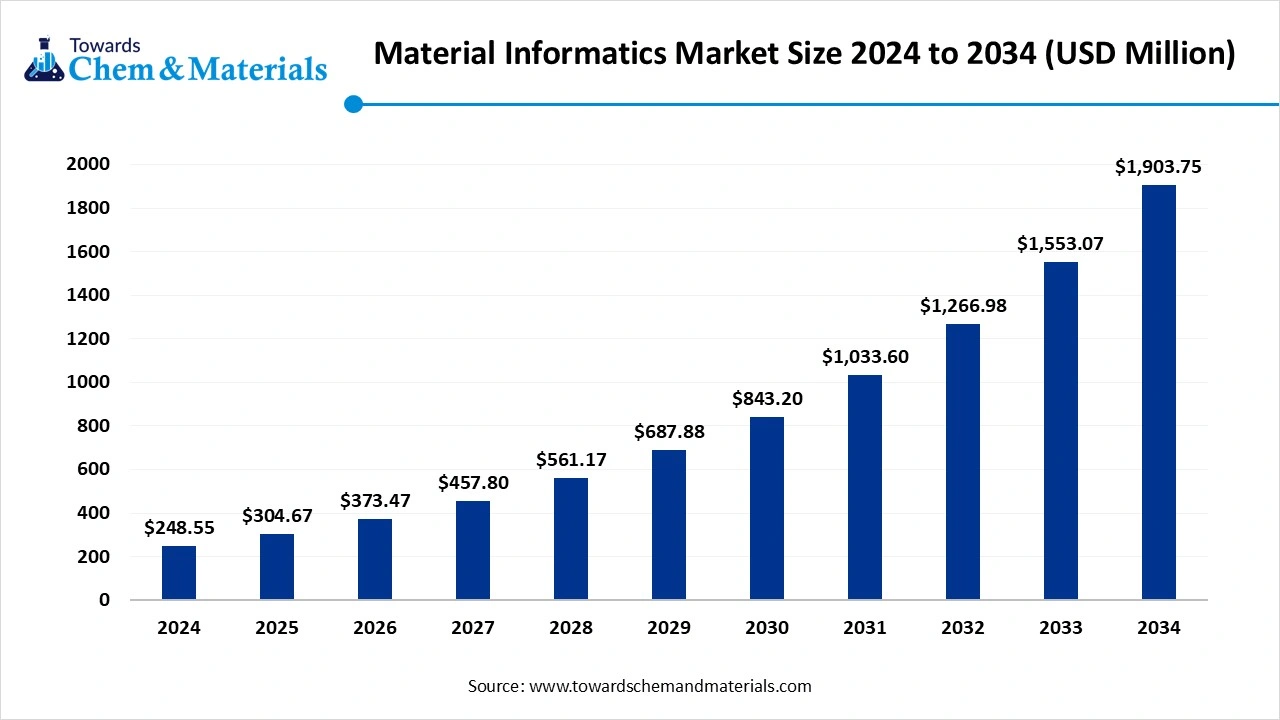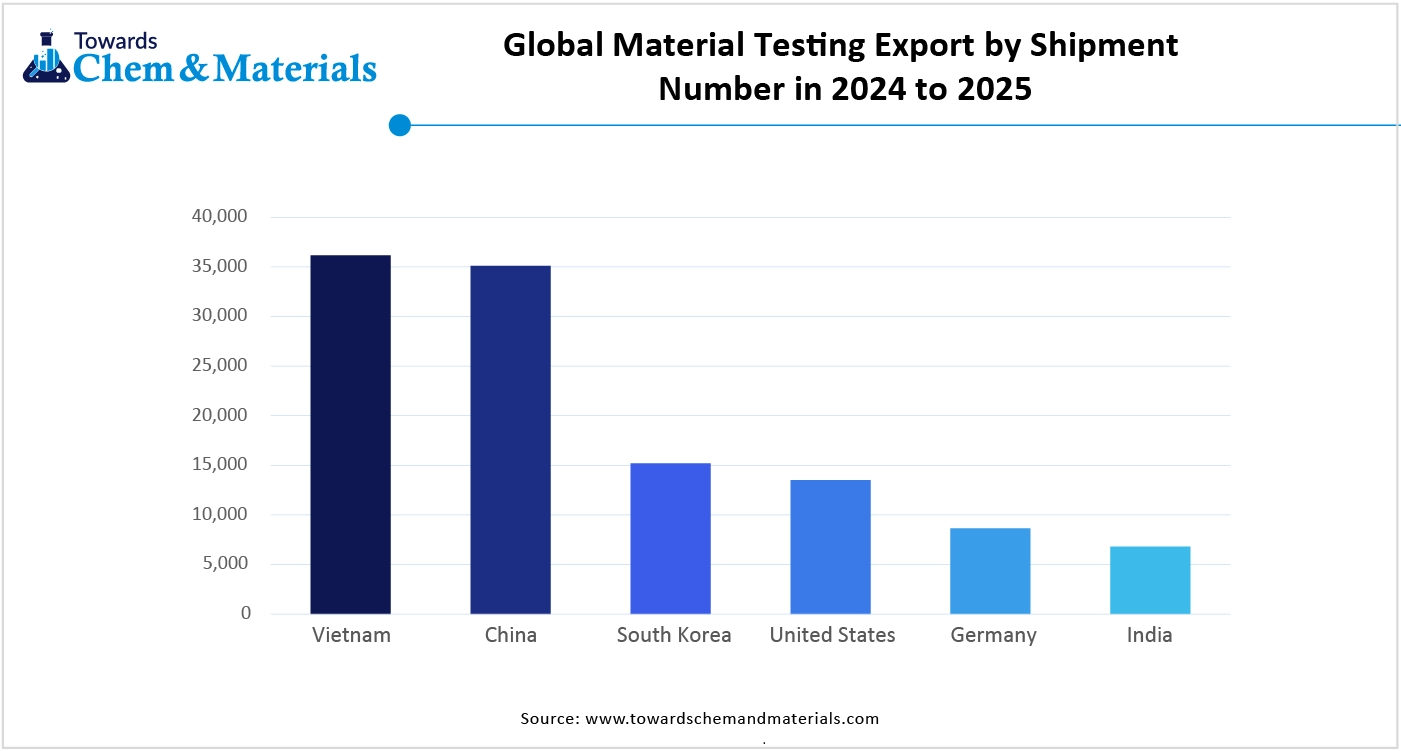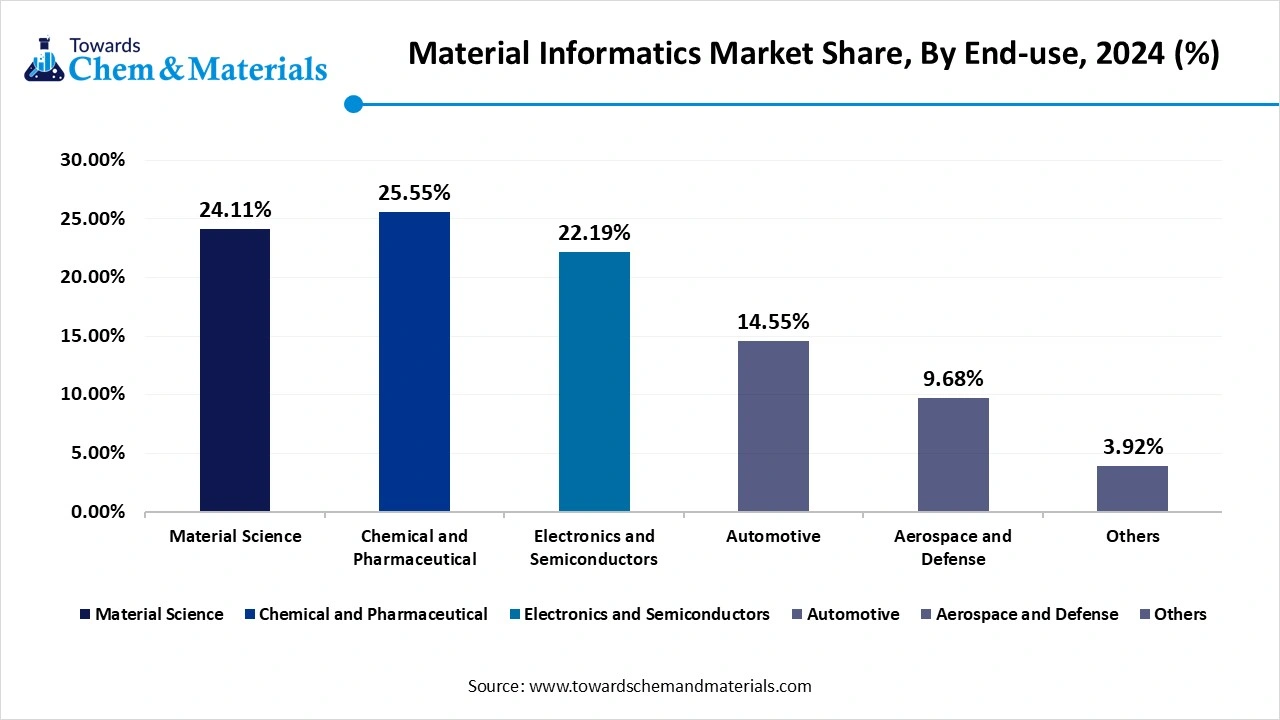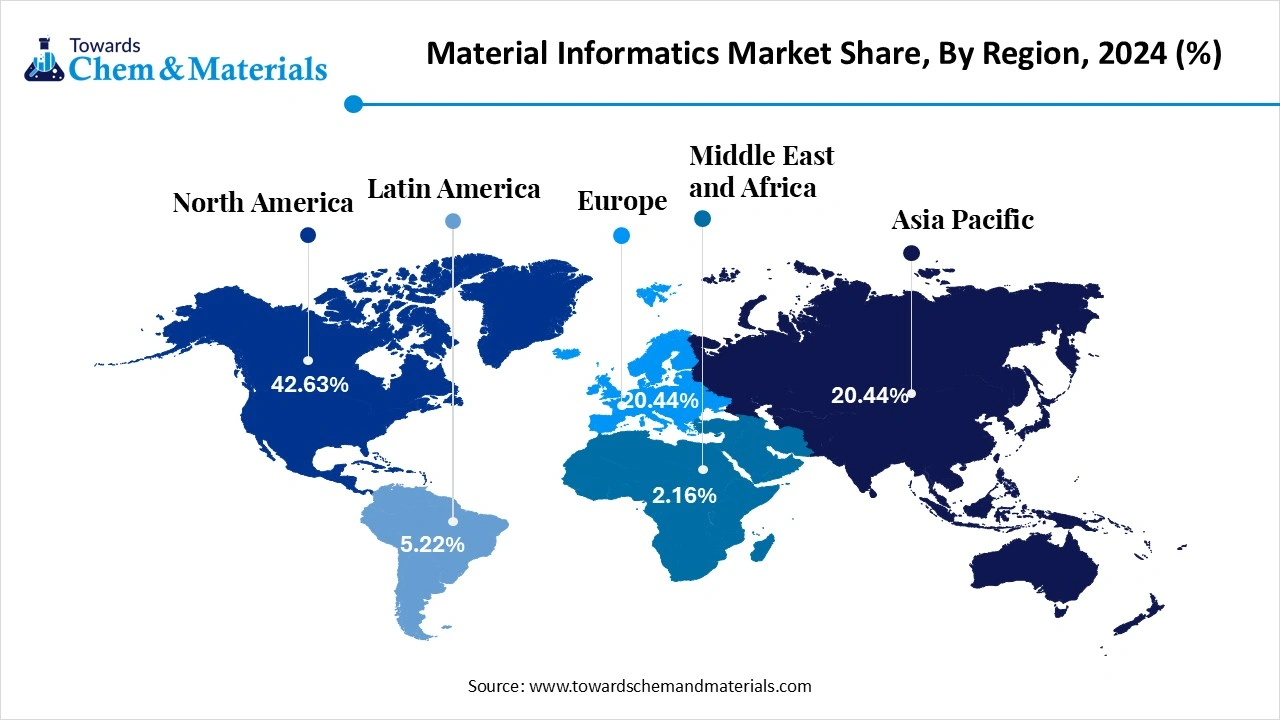November 2025
The global material informatics market size was valued at USD 304.67 million in 2025 and is forecasted to surpass around USD 1,903.75 million by 2034, growing at a compound annual growth rate (CAGR) of 22.58% over the forecast period from 2025 to 2034. The North America dominated the material informatics market with a market share of 42.63% in 2024.

Technology Integration Accelerates Market Growth
The material informatics market is expected to see consistent growth owing to increased use of data, computer tools, and artificial intelligence in the current period. Moreover, several researchers are increasingly using the software in the development of materials instead of regular lab work. Also, the ongoing enlarged expansion of industries such as pharmaceuticals, chemicals, and electronics is actively seen in contributing to the industry growth, as increased use of these technologies for material informatics in the current period. Furthermore, the major companies have been seeking eco-friendly, high-performance, and cost-effective materials in recent years.

What is Driving the Growth of the Material Informatics Industry?
A sudden surge in faster innovation is spearheading industry growth in the current period. Also, several major companies are actively seeking better materials to take the first move advantage in the current industry environment. Moreover, material informatics is increasingly saving time in the material combination process via computer models. Also, the new material informatics has been seen in boosting product development while lowering the research cost in recent years, as per the observation.
AI is poised to transform the material informatics market by accelerating the discovery, design, and optimization of advanced materials through data-driven approaches. Machine learning analyzes extensive datasets from experiments, simulations, and the literature to detect patterns and predict material properties, reducing the need for traditional trial-and-error methods. AI-driven predictive modeling allows rapid screening of compounds, alloys, polymers, or composites, shortening development timelines and reducing R&D costs.
Integrating AI with high-throughput experimentation and computational materials science enables companies to simultaneously optimize performance, durability, and sustainability. AI also supports smarter decision-making in selecting materials for applications ranging from aerospace to electronics, driving innovation in next-generation materials. By pairing predictive insights with automation, AI fosters a more agile, responsive, and cost-efficient materials ecosystem, creating a competitive edge for adopters.
| Report Attributes | Details |
| Market size in 2026 | USD 373.47 Million |
| Market size by 2034 | USD 1,903.75 Miilion |
| Growth Rate from 2025 to 2034 | CAGR 22.58% |
| Base Year of Estimation | 2024 |
| Forecast Period | 2025 - 2034 |
| High Impact Region | North America |
| Segment Covered | By Material Type, By Technology Type, By End Use, By region |
| Key Companies Profiled | ABB, Citrine Informatics, Dassault Systèmes, Elsevier, Hitachi High-Tech Corporation, International Business Machines, Corporation, Lattice Technology, Inc., Microsoft, Phaseshift Technologies Inc., Schrodinger, Inc. |
Medical, Aerospace, and Electronics Boost Material Demand
The increasing need for smart material design and customization is expected to create significant opportunities for the material informatics market in the coming years. Moreover, with the help of data tools, manufacturers can tune the materials' heat resistance, strength, and flexibility in the upcoming period. Also, the sectors such as medical devices, electronics, aerospace, and others will provide a huge consumer base to the market, where every detail matters in these sectors, as per the observation. Also, the company can offer a tailored solution for the specific work instead of the one size fits solution during the forecast period.
High Cost and Complexity Slow Industry Momentum
The higher initial cost and complexity are expected to hinder the industry's potential during the forecast period. The manufacturers need to invest a large amount of time and money in the first phase of material informatics, with sections such as data storage, software, and a skilled workforce. Also, new joiners and mid-sized business firms cannot afford this expensive thing, which is anticipated to hamper their growth during the period. Also, the lack of good data quality is another growth barrier for manufacturers in the current period, as per the observation.
The elements segment held the largest share of the material informatics market in 2024, akin to elements are considered the building blocks of all materials. Moreover, elements such as copper, silicon, iron, and carbon are seen in heavy usage in research and industry, as per the observation. Also, the elements are easy to work with using data tools and computers, which is contributing to the industry's growth in the current period. Also, these specialized characteristics made elements to most commonly used material type in a few fast years, as per the
The chemicals segment expects the significant growth in the market during the predicted timeframe, owing to its becoming a more crucial process in material informatics. Several sectors, such as plastics, coatings, and pharmaceuticals, are increasingly demanding safer and better chemicals in the current period. Materials informatics are likely to help with testing and discovery of new chemicals using computers and data models, which is severely contributing to the industry's growth during the projected period. Also, as the demand for eco-friendly and advanced chemicals grows, companies are likely to use informatics to scale their chemical innovation in the upcoming years.
The machine learning segment held the dominant share of the material informatics market in 2024 due to its ability to learn patterns from large-scale data. The companies are increasingly researching links between properties of materials and material structures, where machine learning technology is helping them out with this process in the current period. Also, the machine learning process is seen as an ideal choice for the creation of materials while reducing the need for longer experiment timings in recent years.
The statistical analysis segment is seen to grow at a notable rate during the predicted timeframe, owing to an increased need for understanding small technical problems that hamper the material performance. Moreover, several companies are seen working on details and customized materials in the current period, which statistical data is likely to help them future with small and limited data sets that machine learning takes time needed more data sets. This is expected to drive the growth of the segment during the forecast period.
The chemical and pharmaceutical segment dominated the material informatics market with the largest share in 2024 due as these industries are the biggest users of material informatics so far. This is because these industries depend on discovering and testing new molecules, drugs, and materials. Material informatics helps them speed up the process using data and simulations. It reduces the time and cost needed to bring new products to market. Drug makers, for example, can find better compounds faster. Similarly, chemical companies can design safer and more efficient materials. Since these industries work with many complex compounds, they were among the first to use informatics for research and product development.

The electronics and semiconductors segment is seen to grow at a notable rate during the predicted timeframe. These industries need very advanced materials for chips, sensors, and batteries. They also need fast innovation to keep up with technological demand. Material informatics can help discover materials that are smaller, stronger, and more efficient. This saves time in the lab and helps companies stay ahead in a competitive market. As electronics become more complex and miniaturized, the need for new materials will rise, making this segment a major driver of growth in material informatics.
The North America material informatics market size is calculated at USD 129.27 million in 2025 and is predicted to increase from USD 158.46 million in 2026 to approximately USD 807.77 million by 2034, expanding at a CAGR of 22.57% from 2025 to 2034.

North America dominated the material informatics market in 2024, akin to having a strong research infrastructure with high industry growth in the current period. Moreover, the countries in the region are seen investing heavily in technology, material innovation science from the past few years. Also, several industries and major companies are using AI tools and data from previous years for the discovery of new materials in the region. Furthermore, the early adoption of technological advancements has contributed to industry growth in recent years, as per the observation.
Is the United States Leading the Global Race in Material Information?
The United States maintained its dominance in the material informatics market owing to enlarged research lab infrastructures and the presence of major companies in the country for the current period. Moreover, the government is increasingly seen in releasing attractive initiatives and funding for the research program in the United States earlier, which can contribute to the industry growth during the forecast period. Also, the ongoing and faster development of AI tools will gain major market share in the formation of the material informatics industry during the projected period.

Asia Pacific expects the fastest growth in the material informatics market in the future, owing to growing industry development and increased demand for advanced materials in the region. Moreover, the rational countries such as China, Japan, India, and South Korea are increasingly seen as putting heavy spending in technology and science programs, which is expected to contribute to the industry growth during the forecast period. By increasing focus on renewable energy, chemicals, and electronics, leading to a need for better materials in the region, which is anticipated to increase market potential in the region, as per the observation.
Is China Set to Dominate the Future of Advanced Materials?
China is expected to rise as a dominant country in the Asia Pacific region in the coming years, owing to the ongoing advanced materials research with novel technology. China is considered the most technologically advanced region globally in the current period. Moreover, as per the recent observation, the companies in China are seen as applying material informatics to the development of semiconductors, batteries, and crucial materials for electric vehicles in recent years. Also, the favorable government initiatives and support can lead to a major profit margin for the producers and manufacturers in the coming years in China.
By Material Type
By Technology Type
By End Use
By Region
According to the new research report, the global green cement market size was valued at USD 38.19 billion in 2024, grew to USD 40.54 billion in 2025, ...
November 2025
November 2025
November 2025
November 2025